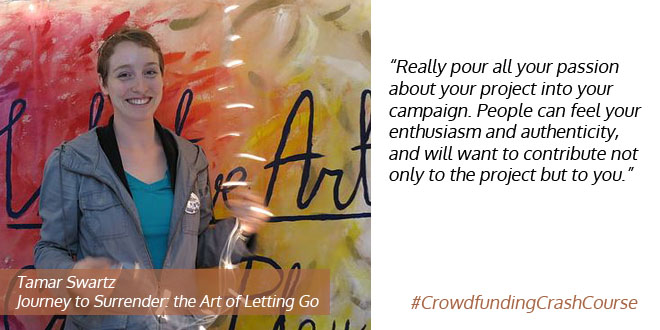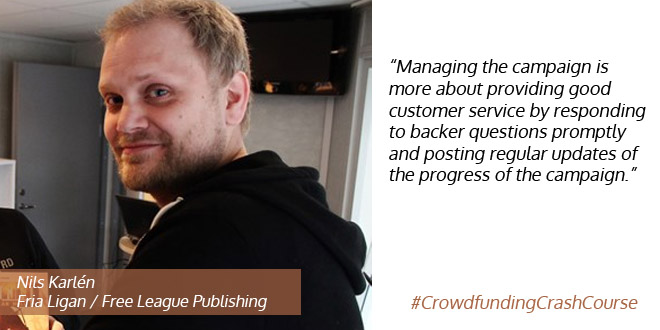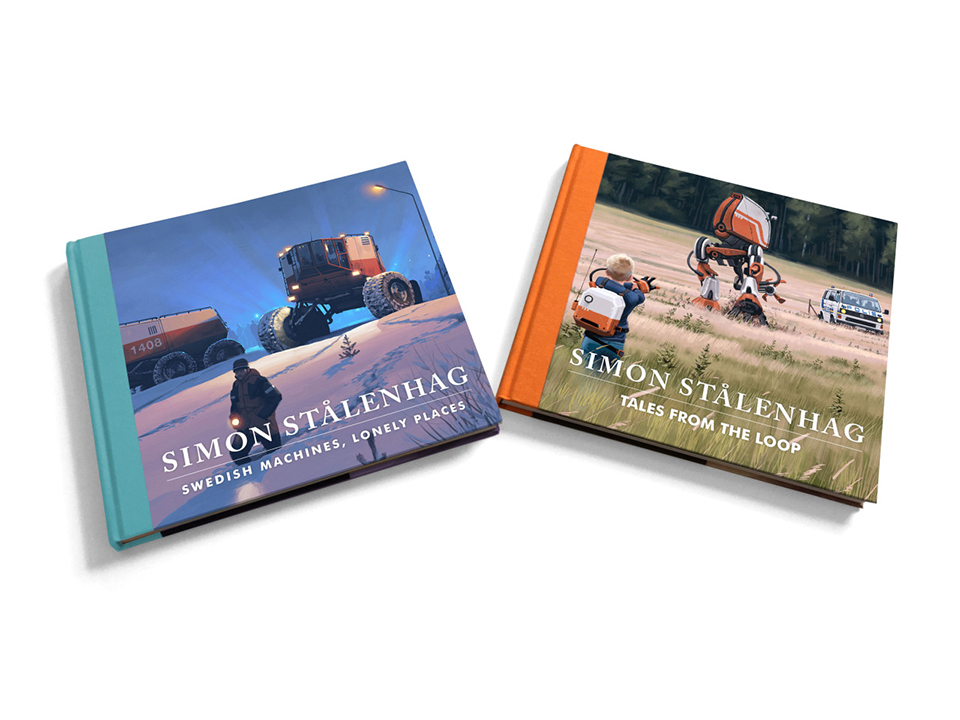Tagged: art
Crowdfunding Crash Course: Tamar Swartz - Journey to Surrender
- by Alyson Shane

Tamar Swartz is a Canadian mixed media visual artist following her creative intuition in painting, drawing and collage. She used Indiegogo to fund her art project Journey to Surrender: The Art of Letting Go.
Can you briefly describe Journey to Surrender: The Art of Letting Go?
Journey to Surrender: The Art of Letting Go is a creative project currently being developed during a 6 month artist residency in Budapest, Hungary. It’s about following your own creative intuition and allowing a piece of art to emerge and breathe, like any living organism would. It’s about trusting yourself and embracing the creative process while releasing conceptual and intellectual approaches to art making.
Journey to Surrender is a three-part project. Part one is my own mixed media visual art practice and walking the pathways of Creative Surrender. Part two is collaborating with other artists to find Creative Surrender together. Part three is facilitating workshops for local participants to experience this form of expressive visual art making.
Once the project is complete, my experience will be integrated into the Intuitive Art workshops that I facilitate. You can read more here.
Why did you feel that the crowdfunding model was the best way to promote the project?
A large part of the project is to have other people involved and engaging with expressive mixed media visual art and Creative Surrender. Crowdfunding seemed like an obvious choice to spread the word and build momentum about realizing Journey to Surrender. Additionally, once the artist residency is completed, I will be integrating what I have learned into my Intuitive Art workshop facilitation.
Why and how did you choose Indiegogo over other crowdfunding options available?
I looked at Kickstarter as an option, but wasn’t completely sure about the all/nothing model for Journey to Surrender: It seemed like a big leap of faith.
I was also under the impression that my project would have to first be approved by Kickstarter before the campaign launches, a process that takes time. I was on a short timeline and ready to start the campaign. Indiegogo has a really easy to navigate platform and their customer service is very helpful.
How big was your budget before you launched your crowdfunding campaign?
I’m not 100% sure how to answer this question…are you asking about the financial resources that were needed to make Journey to Surrender happen, that I had before starting my campaign? If so, $0. Or, are you asking about how much money I spent building/marketing my campaign? $0 but a lot of time, energy and creativity.
How far along was your project before you felt ready to launch a crowdfunding campaign? In hindsight, would you have preferred to be farther along, or to have crowdfunded earlier?
Journey to Surrender did not officially start until I landed in Budapest, so my Indiegogo campaign was a “pre-project” campaign. Within the week that I received confirmation that my residency application was accepted, I started building my campaign. I drew on my Intuitive Art facilitating experience (2 years) and all my art from my own creative practice. It was now-or-never for me.
Can you explain how you prepared for and managed your campaign?
It took about 2 weeks building my campaign. I spent a lot of time making sure it clearly said what I wanted, adding photos that represented Intuitive Art, and designing perks at different price levels. I asked a few close friends to check it before I launched and got some valuable feedback. Also, these friends were “cheerleaders” throughout the campaign and helped me spread the word about Journey to Surrender.
I also made a timeline of my campaign and set up a schedule of when to send out invites and reminders to participate in the campaign. I was successful in not spamming people. I also made funding goal targets, which turned out to be flexible.
What tools did you use to market your campaign? Do you feel like you did so successfully, and if not, what could you have done differently?
I mostly used social media and personal social networks to market my campaign. I posted on my Facebook, Twitter and Instagram accounts. Hashtag everything!
I also sent a lot of personal emails and Facebook messages to friends, family and acquaintances who I thought would be interested in knowing about my project. I received a lot of positive feedback.
Out of all the generous contributions, only 2 were received from complete strangers. Next time I would like to know how to crack that line between friends/family/acquaintances and complete strangers.
In retrospect what were your best assets for running this successful campaign? On the other hand, what would you do differently?
My best asset for this campaign was my enthusiasm and a really compelling combination of a written pitch, images of my art and perks that were appealing. I received a lot of positive support from friends and family!
I think that having a campaign video could be fun for next time. But, I realized that for Journey to Surrender it wasn’t completely necessary.
What was your biggest challenge during your campaign?
Holding faith that it would be successful. There are days where no one contributes or seems to be talking about it, which is feels like nothing is happening. But, even on those days I had to remind myself that contributions come in waves. It was really incredible how in the last 42 hours people really rallied and funds were literally flowing in. Journey to Surrender ended up being 135% funded! There’s something about the pressure of the campaign ending that motivates people to contribute.
What’s the most valuable advice you could share with aspiring crowdfunders?
Really pour all your passion about your project into your campaign. People can feel your enthusiasm and authenticity, and will want to contribute not only to the project but to you. Be open to surprises! Sometimes the people who you expect to contribute don’t, and the people who weren’t even on your radar do. Don’t take anything personally and always always ALWAYS practice gratitude. Even the smallest contribution is important. Also, be mindful that sometimes contributions are not monetary.
This post is part of the #CrowdfundingCrashCourse series. You can find the entire series of interviews and summary posts here.
Crowdfunding Crash Course: Nils Karlén - Simon Stålenhag's Tales from the Loop” & "Swedish Machines, Lonely Places
- by Alyson Shane

Nils Karlén runs Fria Ligan (Free League Publishing) and managed the Kickstarter for Swedish sci-fi artist Simon Stålenhag's two art books Tales from The Loop and Swedish Machines, Lonely Places.
Can you briefly describe Simon Stålenhag's “Tales from the Loop” & "Swedish Machines, Lonely Places"?
Simon Stålenhag’s digital paintings of Sweden in the 80’s and 90’s mixes science fiction with realistic landscape scenery. His work has been very popular on the Internet and he has been featured and interviewed by Wired, The Guardian and The Verge among others.
I run a small publishing company called Free League Publishing (or Fria Ligan in Swedish) together with some friends and when we first saw Simon’s paintings we fell in love with the mix of sci-fi and the “Swedishness” of the paintings. A friend came up with the idea that we should work together which we thought was a brilliant idea. So we approached him about making an art book together and had a few drinks when we discoverad that we all liked the same John Carpenter movies from the 80’s. Done deal!
The art book “Ur varselklotet” was published last autumn in Sweden and got an overwhelmingly good response. Two print runs later, and a lot of orders from across the world we realized that we had to do an English version as well. As Simon was well ahead with paintings for a second book, we decided it was just as well to crowdfund two books at the same time!

Why did you feel that the crowdfunding model was the best way to promote the books?
It was a natural fit. In part because we knew that Simon already had an enthusiastic fanbase (his Tumblr page has a lot of followers), and partly because we already had done two very succesfull crowdfunding campaigns for our games in Sweden. Also, we knew there was a demand for art books with his paintings as we had received loads of requests from all parts of the world.
Why and how did you choose Kickstarter over other crowdfunding options available?
It was an easy decision. We have previously run two campaigns using the Swedish Fundedbyme for the first and Indiegogo for the second. We really liked Indiegogo and it has a large following in Europe, however when it comes to the US, Kickstarter really is king. So it was natural to choose Kickstarter for this project, and I think the campaigns progress really shows the strength of the platform.
How far along was your project before you felt ready to launch a crowdfunding campaign? In hindsight, would you have preferred to be farther along, or to have crowdfunded earlier?
We are kickstarting two books, the first one was already translated and ready to go more or less. The second one is still in development and as Simon produces maybe one painting a week we are looking at publishing it during 2016. From the perspective of the crowdfunding campaign it would obviously be better if we could deliver both books at the same time, to save shipping costs if nothing more. However, I think it’s really good to be able to deliver something rather quickly, and the first book will be that something!

Can you explain how you prepared for and managed your campaign?
We did have some experience as we had run crowdfunding campaigns in Sweden previously so we the basics covered. However Kickstarter was unknown territory for us so we did do quite a bit of research beforehand. We read articles, looked at some successful campaigns and tried to find common denominators and so on. For instance I learned that having a very low first pledge level (a single dollar or so) is important to get the campaign moving as Kickstarters metrics considers every pledge, big or small. Also early bird pledges was something we picked up during this phase.
Managing the campaign is more about providing good customer service by responding to backer questions promptly and posting regular updates of the progress of the campaign. Also I think it’s very important to listen to the feedback that you inevitable will get from the backers.
What tools did you use to market your campaign? Do you feel like you did so successfully, and if not, what could you have done differently?
We used our own Facebook and twitter accounts to spread the world, but really what made the difference was that Simon himself used his twitter, web page and especially his Tumblr page to market the campaign. We also had a list of international media that we contacted after the launch of the campaign, but initially this met with mixed success as I guess our press release drowned in the mix. However, we got lucky when The Verge featured our project on the first day of the project and word of mouth started to get going, especially through twitter. Since then it has just been snowballing along!
In retrospect what were your best assets for running this successful campaign? On the other hand, what would you do differently?
To be honest our biggest asset was Simon’s paintings. Having beautiful and eye-catching imagery in the campaign cannot be underestimated I think.
The biggest mistake we did was that we did not realize that as a backer you can only choose one pledge level. As we kickstarted two books and had a lot of different levels with just one of the books this proved to be a challenge to handle. It did work out great in the end as we helped backers as much as possible so that they could get both books in the edition they wanted but this one one area where our research did not prove enough.
What was your biggest challenge during your campaign?
To be honest we were taken by surprise the initial success and struggled a bit to provide enough stretch goals to the campaign, so I would definitely say that was our biggest challenge.
What’s the most valuable advice you could share with aspiring crowdfunders?
Do your homework, prepare for success and plan for – if not failure but an uphill struggle. Make sure you got a good set of stretch goals planned and at least an idea of another set if you need to add ones quickly. Also: communicate all the time!
This post is part of the #CrowdfundingCrashCourse series. You can find the entire series of interviews and summary posts here.
